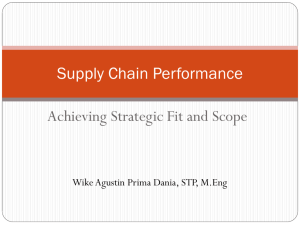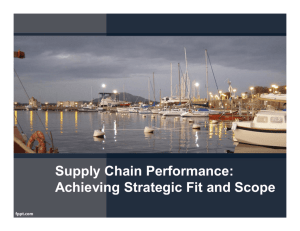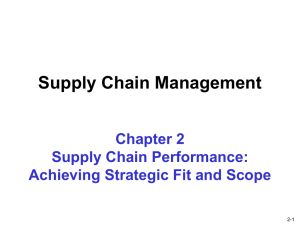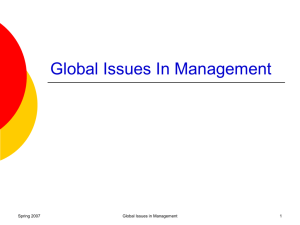Chapter-2: Supply Chain Performance
advertisement
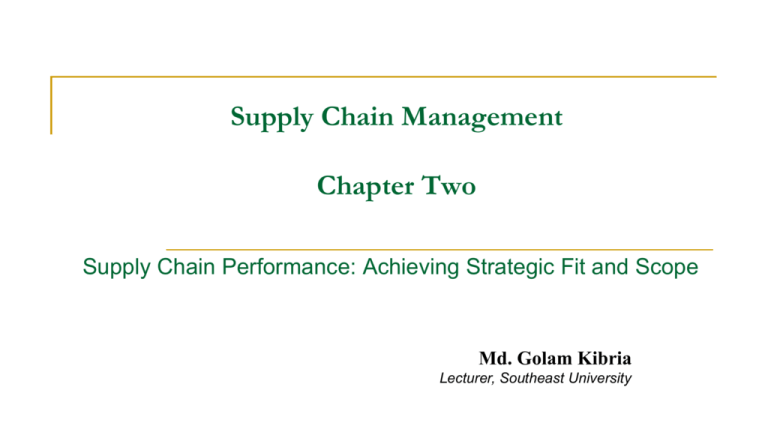
Supply Chain Management Chapter Two Supply Chain Performance: Achieving Strategic Fit and Scope Md. Golam Kibria Lecturer, Southeast University Competitive strategy Competitive strategy defines the set of customer needs a firm seeks to satisfy through its products and services. Example: • Wal-Mart aims to provide high availability of a variety of products of reasonable quality at low prices. • competitive strategy is built around providing the customer with convenience, availability, and responsiveness. With this focus on responsiveness, McMaster does not compete based on low price. Clearly, the competitive strategy at Wal-Mart is different from that at McMaster. Supply chain strategy Supply chain strategy determines the nature of material procurement, transportation of materials, manufacture of product or creation of service, distribution of product. Example: • Dell's decision to sell direct, Gateway's decision to start selling PCs through resellers, and Cisco's decision to use contract manufacturers define the broad structure of their supply chains and are all part of their supply chain strategies. • Amazon's decisions to build warehouses to stock some products and to continue using distributors as a source of other products are part of its supply chain strategy. Similarly, Toyota's decision to have production facilities in each of its major markets is part of its supply chain strategy. The Achieving Strategic Fit Strategic fit Competitive and supply chain strategies have aligned goals A company may fail because of a lack of strategic fit or because its processes and resources do not provide the capabilities to execute the desired strategy. Failure at any one process or function, however, may lead to failure of the overall chain. A company's success or failure is thus closely linked to the following keys: 1. 2. 3. The competitive strategy and all functional strategies must fit together to form a coordinated overall strategy. The different functions in a company must appropriately structure their processes and resources to be able to execute these strategies successfully. The design of the overall supply chain and the role of each stage must be aligned to support the supply chain strategy. How is Strategic Fit Achieved? 1. Understanding the customer and supply chain uncertainty 2. Understanding the supply chain 3. Achieving strategic fit Understanding the customer and supply chain uncertainty • To understand the customer, a company must identify the needs of the customer segment being served. • In general, customer demand from different segments varies along several attributes as follows: • • • • • • Quantity of product needed in each lot Response time customers will tolerate Variety of products needed Service level required Price of the product Desired rate of innovation in the product Implied Demand Uncertainty is the resulting uncertainty for only the portion of the demand that the supply chain plans to satisfy and the attributes the customer desires. For example, a firm supplying only emergency orders for a product will face a higher implied demand uncertainty than a firm that supplies the same product with a long lead time, as the second firm has an opportunity to fulfill the orders evenly over the long lead time. Understanding the supply chain Capabilities • Creating strategic fit is all about creating a supply chain strategy that best meets the demand a company has targeted given the uncertainty it faces. • Like customer needs, supply chains have many different characteristics that influence their responsiveness and efficiency. • Supply chain responsiveness includes a supply chain's ability to do the following: • • • • • Respond to wide ranges of quantities demanded Meet short lead times • Handle a large variety of products Build highly innovative products Meet a high service level Handle supply uncertainty • Supply chain efficiency is the inverse of the cost of making and delivering a product to the customer. Increases in cost lower efficiency. For every strategic choice to increase responsiveness, there are additional costs that lower efficiency. Achieving Strategic Fit • After mapping the level of implied uncertainty and understanding the supply chain position on the responsiveness spectrum, the third and final step is to ensure that the degree of supply chain responsiveness is consistent with the implied uncertainty. • The goal is to target high responsiveness for a supply chain facing high implied uncertainty, and efficiency for a supply chain facing low implied uncertainty. • For example, the competitive strategy of Dell targets customers who value having customized PCs delivered within days. Given the vast variety of PCs, the high level of innovation, and rapid delivery, demand from Dell customers can be characterized as having high demand uncertainty. • Dell has the option of designing an efficient or responsive supply chain. • An efficient supply chain may use slow, inexpensive modes of transportation and economies of scale in production. If Dell made these choices, it would have difficulty supporting the customer's desire for rapid delivery and a wide variety of customizable products. • Building a responsive supply chain, however, will allow Dell to meet its customers' needs. Therefore, a responsive supply chain strategy is best suited to meet the needs of Dell's targeted customers. • Now, consider a pasta manufacturer such as Barilla. Pasta is a product with relatively stable customer demand, giving it a low implied demand uncertainty. Supply is also quite predictable. Barilla could design a highly responsive supply chain in which pasta is custom made in very small batches in response to customer orders and shipped via a rapid transportation mode such as FedEx. This choice would obviously make the pasta prohibitively expensive, resulting in a loss of customers. Barilla, therefore, is in a much better position if it designs a more efficient supply chain with a focus on cost reduction. Expanding Strategic Scope • Intrafunctional view – minimize total functional cost • Firms align all operations within a function • Interfunctional scope – maximize company profit • Functional strategies are developed to align with one another and the competitive strategy • Intercompany scope – maximize supply chain surplus • Supplier and customer work together and share information to reduce total cost and grow supply chain surplus • Agile intercompany scope – a firm’s ability to achieve strategic fit when partnering with supply chain stages that change over time Different Scopes of Strategic Fit Across a Supply Chain Figure 2-7

